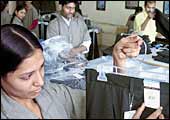|
Tech rules.
That's the strong message that comes from the second annual listing
by this magazine of companies that have used information technology
to their advantage (and ours). The listing is diverse enough to
display the universal benefits of technology: there are the wired
buffaloes of Maharashtra's Chitale Dairy, the restoration and colourisation
software of the Indian Academy of Arts and Animation (the people
who restored Mughal-e-Azam), the GPS-enabled fleet (or part of it)
of the Karnataka State Road Transport Corporation, and the e-education
initiative of the Tamil Nadu government and the state's Anna University.
There are also representatives from usual suspects banking and IT
such as IBM, Bharti Tele-Ventures and HDFC Bank. The moral: it isn't
who you are or what technology you use that counts; it is how you
use it that does.
APOLLO HOSPITALS
Remote relief provider
Call The Doctor
 |
| Apollo Hospitals' Chairman Dr. P.C. Reddy:
The pioneer in organised healthcare is now eyeing another
frontier, telemedicine; last year some 13,000 patients across
the country availed this service |
This writer can
speak about Apollo's medical equipment (the chain is arguably the
best equipped in India) or its medical business process outsourcing
initiative (through subsidiary Apollo Health Street), but she'd
rather talk about the 13,000 patients that availed the chain's telemedicine
service last year. Telemedicine may be one of those buzzwords that
have been doing the rounds for some time, but 2004 saw the number
of patients availing Apollo's facility double. The13,000 includes
patients from Dimapur, Nagaland, Kovilpatti, Tamil Nadu, Andaman
& Nicobar, even Lahore. The chain's 70 telemedicine centres
promise not just super-speciality consultation, but even consultation
for basic specialities. Doctors view diagnostic tests online and
offer their advice to patients. "With the help of technology
we have widened the gap between us and our nearest competitors,"
says Ashok Anantaram, Head (Business Development), Apollo. Well,
if it is distance that is being discussed, Apollo has rendered the
one between doctors and patients irrelevant.
-Nitya Vvaradarajan
BHARATPLANET
Online application seller
Death Of A Salesman
 |
| BharatPlanet's T. Chandramohan: Look
Ma, no salesmen, and we are actually thriving |
One day in the
middle of 2004, T. Chandramohan, the founder and CEO of BharatPlanet,
a Chennai-based provider of web applications, decided to do away
with his marketing team. That was a big call for a company that
had, until then, depended on a marketing team, here and in the US,
to bring home the bacon, but Chandramohan was convinced that online
sales would do the trick. It did. Expenditure plummeted while monthly
revenues had trebled by November 2004. BharatPlanet's products-a
mass e-mailing facilitator, a workforce application and a core application
for direct sellers-are largely targeted at small- and mid-sized
firms in India and the us that pay between $5,000 and $30,000 (Rs
2,20,000 to Rs 13,20,000) for an application, money that translates
into a billing rate of between $12 (Rs 528) and $14 (Rs 616) an
hour. Online selling works for his company, reasons Chandramohan
because, "there is no blind selling; we reach only the target
audience".
-Nitya Varadarajan
 |
| See the smile? In 2004, Bharti Tele-Ventures
gave customers enough reason to; here an obviously happy customer
fiddles with her BlackBerry, an e-mail-on mobile device launched
by the company in India |
BHARTI TELE-VENTURES
BlackBerry, WiMax and more, that's why
Technology Edge
Its own internal
it function outsourced completely to IBM, Bharti Tele-Ventures-it
provides telephony and broadband services under the Airtel brand
and has over 10 million mobile telephony customers alone across
India-spent much of the year adopting the kind of innovative technologies
that reduces costs, makes a difference to the customer or changes
the rules of the game. Among these are the launch of BlackBerry,
its pilot project to implement WiMax, a wireless broadband technology,
its roll-out of edge networks to facilitate the next level of data
services, and things like Hello Tunes, which allows users to customise
the tone anyone calling them up will hear. "We have done quite
a few things across our network, it and for the end-user,"
puts Jai Menon, Corporate Director (it & Technology), Bharti,
succinctly. That it has.
-Supriya Shrinate
CDFD
The DNA-fingerprinting people
Hi-tech Cop And More
There's little
that suggests Seyed Eehtesham Hasnain, the ever-smiling, 50-year-old
director of the Hyderabad-based Centre for DNA Fingerprinting and
Diagnostics (CDFD) is a policeman, yet every time he meets with
police officers, a frequent occurrence in his case, he is asked
which batch of the Indian Police Service he belongs to. That's because
of the growing use of DNA fingerprinting in law enforcement and
investigation, a phenomenon that has seen CDFD, as it is popularly
abbreviated, become a brand of sorts. Yet there is more to the institute
than meets the eye: it is creating databases of endangered species
of animals, disease patterns across India and convicts, (DNA) fingerprinting
plants and seeds for the purpose of filing patents, and working,
in association with Sun Microsystems, to set up the world's first
centre of excellence in clinical bioinformatics. Wired? You bet,
and organically so.
-E. Kumar Sharma
 |
| Chitale Dairy Farms: The future of dairy
farming is here |
CHITALE DAIRY FARMS
Digital Dairy
Four Legs Better
The buffaloes at
Chitale Dairy's Farm in Bhilawadi, a town 250 km from Pune in Maharashtra,
and in 12 satellite farms in the vicinity, sport radio frequency
id (rfid) tags, so that the company can monitor and control every
aspect of their lives that has a bearing on their output. "Cost
reduction at every level is critical and this is where technology
comes in," explains Vishwas Chitale, who handles the dairy
operations for this family-controlled business whose turnover is
in the region of Rs 150 crore. There's more. The aforementioned
RFID tags carry information to the company's technology nervous
system, Control Net; this, in turn, uses these as inputs to control
the automated production plants that are wired with soft logic processors.
"All production data, which is logged and analysed, is finally
available to the top management on call so that production costs
can be monitored," adds Chitale. Henry Ford would have been
very very impressed.
-Priya Srinivasan
DELHI METRO RAIL CORP.
Drive-by-tech
On Track
 |
| DMRC's Managing Director E. Sreedharan: Smart
tunnels; smarter technology |
Delhi's DMRC-it
would have, by march 2006, commissioned 63 km of track-is a heavy-enough
user of technology (it has invested some Rs 900 crore in it) to
claim that it can run trains without a driver. "I doubt commuters
would like that," grins R.S.T. Sai, General Manager (Finance),
DMRC. The entire length of the Metro is linked by fibre-optic cable,
the backbone of the company's communication system that manages
the automated signalling process and provides bandwidth for cellular
companies wishing to be on-air in a subterranean environment. "The
it practices we have in place are comparable to the best in the
world," boasts Prashant Rao, Chief Communication Engineer,
DMRC. So much so that even the company's smart card-based automated
fare collection system comes with a mechanism to prevent loitering
(if you have not left the Metro system 75 minutes after you have
entered it, the smart card readers will alert the cops).
-Kushan Mitra
 |
| Godrej & Boyce's Deputy General Manager
Barinder Singh: This isn't a phone; it is a conduit into
the organisation's ERP system |
GODREJ & BOYCE
The mobile phone can do even more
A Nifty Key
It's purely one
of those perceptual things, but Godrej & Boyce, a company with
eight business divisions spanning refrigerators, furniture, security
equipment, typewriters and storage isn't top-of-the-mind for this
writer when it comes to being wired. Still, in what must be a first
of sorts, Godrej & Boyce's entire ERP (enterprise resource planning)
system, an information-aided management support system that runs
through the company, is available to all executives in the sales
and marketing function on their mobile phones. Godrej & Boyce
worked with telco Hutch to design a SIM (subscriber identity module)
card with a customised menu that makes it possible for the user
to access information on billings, outstanding payments, collections
and stock position. Users can also access specific information by
sending an SMS that is routed to the company's server, which, in
turn, replies with the information, again in SMS format, through
a modem. Users can also set alerts to access information according
to a pre-ordained schedule. For instance, a regional sales manager
can set an alert to access information on weekly sales in a particular
city every Friday at close of business; the server will generate
the information on the basis of invoices generated and SMS it to
the manager. Some 3,000 employees of Godrej & Boyce are currently
part of the wireless deployment initiative and the benefits have
been significant enough for the company to roll it out to 150 dealers.
"We have never adopted technology for the sake of it,"
says George Menezes, Head (Commercial Organisation), Godrej &
Boyce. "We evaluate technologies regularly and adopt them as
and when we need them; we are the first company to offer such a
menu on the mobile phone." That, it is.
-Priya Srinivasa
HDFC BANK
Incremental IT
Sweating The Small Things
 |
| HDFC Bank's NetSafe: The card's auto-destruct
facility should prevent online frauds |
The role of technology
in making HDFC Bank India's best (according to the BT-KPMG study),
as well as helping it grow aggressively, is pretty well known (this
magazine has written extensively on it). That isn't the reason HDFC
Bank finds itself in this listing; the reason for that is the company's
incremental tech initiatives, such as NetSafe, a dynamically generated
self-destructing online payment card (HDFC Bank account holders
can use this to shop online, specifying its time of destruction
while creating it). There are other initiatives along the same line,
SMS-based top-ups for Hutch's pre-paid customers and mobile banking
for Reliance Infocomm subscribers, small things that make a lot
of difference to the user, external and internal (one of the things
the bank's it chief C.N. Ram is proud of is an SMS-based alerts
system for all bank executives in their respective areas of operation).
"The return-on-technology investments is calculated purely
in terms of business benefits, which are either savings realised
through operations or just straight through processing," says
Ram. This is nothing if not a technology based business.
-Priya Srinivasan
 |
| Asmita Thakur @IBM: Thanks to something
called the On-Demand workplace, Thakur is at home in Bangalore,
yet doing her job as an application developer; IBM, clearly,
believes in eating its own dog food |
IBM
Flexiplace employer
At Home, Everywhere
Had she been working
elsewhere, Asmita Thakur, a 30-something young mother would be rushing
into office a little after nine every morning, the effects of a
hectic chore-filled morning and a harried commute showing on her.
Working, as she does at IBM, Thakur, an application developer, just
logs on from home and does her work. Big Blue doesn't make it to
this listing because of this feel-good-young-mother-working-from-home
bit; it does because of something called On-Demand (the term is
popular at the company right now, a corporate theme, selling spiel,
and advertising term rolled into one) workplace. This is a blend
of hardware, software, services and expertise that creates a virtual
environment where employees can do their work and interact with
others, employees, partners, suppliers, even customers. Like a good
tech company, IBM eats its own dog food, which explains why employees
like Thakur can work on-demand. "The benefits of a workplace
that can be accessed from anywhere include cost savings, the ability
to exchange information with mobile workforces, and sharing and
managing business knowledge," says Martin Appel, Country Manager
(HR), IBM India. In a city like Bangalore, where Thakur lives, it
also means freedom from stress-inducing traffic.
-Rahul Sachitanand
INDIAN ACADEMY OF ARTS
AND ANIMATION
The Mughal-e-Azam restorers
Remaking Classics
 |
| Mughal-e-Azam in colour: IAAA's restoration
and colourisation software was the real hero of this magnum
opus |
Two years ago,
a fire at the national film archives in Pune destroyed some treasured
prints. It also got Rajiv Dwivedi, then a 30-something software
jock with the city-based Centre for Development of Advanced Computing,
thinking about how the damage could have been contained. Spotting
an opportunity, Dwivedi teamed up with an old friend, Umar Siddiqui,
and founded Indian Academy of Arts and Animation (IAAA). The duo
planned to digitise existing films and set up an animation school;
instead, it bagged a king-size contract-the restoration and colourisation
of the 1960s classic Mughal-e-Azam. The software did not exist in
India and doing it abroad would have cost over Rs 15 crore as opposed
to the Rs 5 crore the effort cost. So, Dwivedi set out to develop
the software, writing in controls for light, even building in an
artificial intelligence component with the help of historians from
Delhi's Jawaharlal Nehru University, to identify colours of the
Mughal period. Thus, when one animator was trying to colour a rose
red, the software rebelled. Reason? The red rose is a hybrid variety
that came into existence long after Mughal emperor Akbar's time.
The process took over a year, but judging from the critical and
commercial acclaim the relaunch has received, it has been a year
well spent. Impressed, Universal Studios has awarded IAAA the contract
to colourise 20 Sherlock Holmes classics. If you catch sight of
a lot of dressed up vintage footage at the local multiplex you know
where it all began.
-Priya Srinivasan
 |
| ITC IBD's Sivakumar: There's money to
be made in the rural marketplace; the trick is to know what
to charge for and what not to |
ITC
Tapping the real marketplace
Mass Movement
It isn't the technology
it uses that makes ITC's e-choupal initiative, part of the company's
international business division (IBD) that essentially trades in
agri-commodities, unique. It is the way it uses technology: to create
an information chain (rural communities share and receive information
related to markets for their products) layered over with a physical
distribution chain (this facilitates buying from the farmers and,
in turn, selling to them). ITC believes that by leveraging gaps
in infrastructure, it can make money on some services without actually
charging the customer anything. For instance, it can provide printed
copies of land records sourced from a central registry free to farmers,
counting on the footfalls this service generates to its choupals
to sell other products. Some 35 companies, including Monsanto, Marico,
Philips, ICICI, even LIC, have bought into this model and S. Sivakumar,
Chief Executive, ITC IBD, says, "The platform will soon carry
health, education and BPO (business process outsourcing) services."
With 5,050 choupals (and six opening every day) covering 31,000
villages and 3 million farmers, ITC can probably make a go of it.
For the record, since the movement (it is nothing short of that)
began in 1999-2000, the IBD's contribution to ITC's revenues has
doubled from 5 per cent to over 10 per cent (in 2003-04).
-E. Kumar Sharma
KARNATAKA STATE ROAD TRANSPORT
CORP.
GPS user
Eye In The Sky
 |
| Note the black box: This is what helps
the bus talk to a satellite |
Here's a problem
most state-owned transport corporations face. All retain buses on
contract (their ownership is private, but they fly the state transport
corporation's colours); while plying busy routes, these invariably
bypass scheduled stops in small, but congested, towns because that
would mean more road-time, preferring to stick to the faster (and
easier) route. Waiting passengers miss out on scheduled arrivals,
but there is little they can do. Nor can the state transport corporation
monitor things, not unless it has an eye in the sky. That's exactly
what Karnataka State Road Transport Corporation (KSRTC) has done.
Thanks to a Global Positioning System (for the benefit of the uninitiated,
GPS is about the use of satellites, receivers and software to pinpoint
the exact position of an object), the corporation can track the
location of its buses (across the country, should the need arise).
And apart from ensuring that buses make all scheduled stops, the
system can help the corporation "look at speed, fuel efficiency
and turnaround time", according to Bhaskar Rao, Director (Security
and Vigilance), KSRTC. Now restricted to 70 buses, the corporation's
GPS project will soon cover 3,000 of its fleet of 12,000. That's
a start.
-Rahul Sachitanand
 |
| Lason's Nevatia: The company has a revolutionary
vendor management process |
LASON INDIA
Supply chain innovator
Vendor Management
It is common for
carmakers to outsource entire assemblies that are, in turn, outsourced.
Business process outsourcing (BPO) is built around the same premise
although it isn't common to find further outsourcing in this industry.
Lason India, a software-cum-BPO firm that targets the financial
services space, has done just that by outsourcing to a clutch of
60 business associates across Chennai, Pondicherry and Kanchipuram
that together employ 5,000. Lason uses the corDect technology, developed
by IIT Madras, for its wide area network; the company has a web-based
training package that associates can put recruits through; and it
has even customised desktop applications to reduce the threat of
virus attacks. "We invested 1 per cent and got 4 per cent returns,"
gushes Pradeep Nevatia, Managing Director, Lason India. Tech is
like that.
-Nitya Varadarajan
 |
| The right fit: Customers will never have
to be shaped like mannequins, thanks to Madura Garments' Made-To-Measure
initaitive; and the company's ability to capture and act on
fashion quirks helps it tweak its production process optimally |
MADURA GARMENTS
Sharp clothes-smith
Capturing Quirks
Fashion can be
a tricky business. The evanescence of it all can make or break a
business, as any retailer left with a thousand pairs of mukluk-imitation
boots will aver. It is, then, the ability to cope with fleeting
fashion trends with the aid of technology that makes Bangalore-based
apparel maker Madura Garments, part of the Aditya Birla Group, unique,
not its efforts in the direction of customising suits and keeping
this information on a central database (the Made-To-Measure suits
initiative; customers can merely quote their unique customer number
the next time they are ordering a suit, provided they have neither
put on nor lost weight) or creating business- and employee portals
(these are, no doubt, laudable, but it is the fashion bit that earns
the company a mention in this listing). Thus, executives at the
company do not dismiss a customer buying a white shirt rather than
a blue one as a quirk, as most executives at other companies are
likely to; instead they collate data on buying patterns and use
the same to weed out underperforming stock-keeping units and stocking
up on popular ones. "We can't have technology in isolation;
we have integrated it with our customer services," says Hemachandra
Javeri, President, Madura Garments.
-Rahul Sachitanand
 |
| MTR's Suresh: In the sambhar he is stirring,
and in all other products of the company, IT is the key ingredient |
MTR FOODS
Intelligent ERP user
The Secret Ingredient
Those reluctant
to use the term complexity in association with the foods business
clearly do not know MTR Foods. The Bangalore-based firm, an offshoot
of that hallowed eatery Mavalli Tiffin Rooms, makes and sells some
240 different ready-to-eat foods, mixes and spices. Each stock-keeping
unit (SKU), in turn, requires the use of 15-odd ingredients in varying
quantities, with additional constraints regarding quality thrown
in. For instance, the cumin powder used in channa masala (a traditional
north Indian preparation involving a type of lentil) powder has
to have a certain level of moisture-too little moisture, explain
the company's in-house experts, will make the powder too dry and
too much will kill the taste. A small company can afford to get
away with hand measures and the consequent variation in taste across
batches; not MTR Foods, a Rs 123-crore company in which JP Morgan
partners, the private equity arm of JP Morgan Chase, has a 28 per
cent stake, and is headed by J. Suresh, who once ran Hindustan Lever
Limited's beverages business. The company's response has been to
implement an enterprise resource planning package from sap, and
leverage this to monitor both production and sales. "Technology
helps us solve complexity," says Suresh. "We operate in
a wide range of categories and technology helps us keep track of
all our products." The man is also counting on technology to
help the company's overseas prospects. Although 80 per cent of MTR
Foods' revenues comes from the domestic market, it has slowly increased
its presence in the US and the UK. "There are over 1.8 million
Indians in the us and many of them want to eat home food,"
says Suresh. Crunching order and delivery times is one thing; creating
an online-interface for customers to check on the status of their
orders is another. And to think it all began with a restaurant.
-Rahul Sachitanand
PANTALOON
RFID innovator
Clothes Tags
 |
| RFID @ Pantaloon: An employee at Pantaloon's
warehouse displays the tags the company's apparel now come with;
bar code readers and scanners are irrelevant |
That Pantaloon
retail is one of India's more aggressive retail companies is well
known; what isn't is its standing as a technology innovator. The
company has initiated a pilot on the use of radio frequency identification
(RFID) tags at its warehouse in Tarapore to streamline its supply
chain process. Currently being applied to its private label, the
RFID tagging will be extended to other suppliers shortly. Apparel
tagged with RFID at the factory makes its way to the warehouse,
and then leaves the Pantaloon premises when the sale is booked.
Right through this process, there is no human intervention at all.
"This eliminates the need for bar coding and scanning completely;
the in-house ERP system picks up the RFID data, thereby recording
every single transaction," explains Chinar Deshpande, Head
(it), Pantaloon.
-Priya Srinivasan
 |
| The final touches: A technician at Prime
Focus' post-production facility fine-tunes a mainstream production;
thanks to the company, Bollywood releases now look as slick
as, well, ad films |
PRIME FOCUS
Bollywood's own cutting-edge post-production house
Take The Red Pill
The burly brawl
it isn't, but the inspiration behind several Akshay Kumars (one
Bollywood hunk in the singular) fighting a lone Salman Khan (another
Bollywood hunk) in Mujhse Shaadi Karogi? (Will you marry me?), a
motion picture released in 2004, is apparent. The sequence was made
possible by a Milo motion control rig, a product that fetched its
creators an Academy Award (Academy of Motion Pictures, Arts &
Sciences Scientific and Engineering Award) in 1999 ("This radically
original and effective solution to the problems of high-speed camera
motion was achieved with the combination of novel geometry and dedicated
three-dimensional control software," said the Academy in its
release). The Milo is just one of the ways in which Prime Focus,
a Mumbai-based post-production house, is making Bollywood edgier,
at least in terms of technology. Another, a more visible change
effected by the company, is the way some of the newer releases,
such as Musafir (Traveller) and Naach (Dance) look, smooth, like
a 30-second ad film or a Hollywood motion picture. This is the effect
of digital intermediate technology, tech-speak for transferring
motion pictures from analogue to digital format, upgrading picture
quality through colour correction and other means, and then transferring
them to the analogue format (negatives) again for screening. Prime
Focus, which claims to be the largest facility of its kind in Asia,
employs this technology on a scale that would make a mass-manufacturer
envious. The company handles the post-production of at least two
big banner motion pictures every month, 60 per cent of all ad films
made and 80 per cent of motion picture trailers. "We see a
25 per cent increase in the technology budgets of filmmakers year-on-year,"
says Namit Malhotra, Managing Director, Prime Focus. The man has
a simple benchmark for rationalising all technology investments
(like the Milo in which Prime invested). "On any new service
line where the investment is in the region of Rs 8-10 crore, I look
at a 36-month recovery period; it's a question of blending technology
with market expectations." That is a blend this studio has
perfected.
-Priya Srinivasan
RANBAXY
Digital documentation
Magic Pill
 |
 |
| Ranbaxy's hi-tech lab: Its digital output
accelerates application filing |
Ranbaxy's tryst
with hi-tech began with a mandate from Wal-Mart, a pioneer in the
use of technology to manage vendors and inventory, and one of the
company's largest customers in the us, that all prescription drugs
of a certain type needed to be tagged with radio frequency id (RFID)
tags that contained all information relevant to the product. That
was in the middle of last year. Since then, Ranbaxy, no laggard
itself when it comes to technology (even in 2003 the company had
started work on electronically filing applications for approvals
for marketing drugs in the us to that country's Food and Drugs Administration,
FDA, a first for an Indian company) has leveraged it to good effect
along two dimensions: monitoring its considerable R&D efforts
(the company's R&D lab is based in Gurgaon and the initial emphasis
was not on automation but, justifiably, on getting the basic research
infrastructure in place), and archiving data so as to generate online
the substantial documentation accompanying any filing it makes to
the FDA. Today, 300 of the 1,200 nodes in the company's R&D
network are connected to a central database and all data is collected
and archived automatically. "This helps us to control our data
better and aids collaborative decisions, because one lab can see
data coming from the other at any given time," says Dinesh
Thakur, Director (Research Information and Project Management),
Ranbaxy. The online process reduces the time required to archive
data by as much as 60 per cent to 80 per cent in some cases and
makes the data required to file applications available on tap; even
better, all data is in electronic format. Storing, archiving and
documenting data related to the drug manufacturing and discovery
processes is becoming increasingly important in the pharmaceutical
industry, and Thakur is confident that Ranbaxy's investments in
technology will result in a return of investment of anything between
15 per cent and a fulsome 100 per cent in the long term.
-Supriya Shrinate
 |
| Anna Earth Station: The university, already
into satellite education, and the govenment are working on e-education |
TAMIL NADU GOVERNMENT-ANNA
UNIVERSITY ALLIANCE
Wired education network
School Online
If all goes well,
by 2007, Tamil Nadu will be the most wired state in the country
from the perspective of e-learning, or e-education. At the core
of this Rs 20- crore project that will kick off next month, is a
Knowledge Data Centre (kdc) coming up at Tamil Nadu's Anna University
(it is based in Chennai and is the government's partner in this
exercise). The KDC will house information, in digital format, that
can be accessed by students across the state. "The data centre
will become a technology resource," explains E. Balagurusamy,
Vice Chancellor, Anna University, adding that the centre will connect
all engineering colleges, government-run polytechnic institutes,
medical colleges, law, arts and science colleges, and higher secondary
schools. In effect, the KDC will become the central hub for promoting
research activities, apart from disseminating knowledge (of course)
and offering services such as e-learning, distance learning, a digital
library and the like (phew!). In the first phase itself, KDC is
expected to save some Rs 10 crore for the government: first- and
second-year engineering students will substitute some lectures with
KDC content. Will it work? Well, Tamil Nadu is wired enough to make
it happen and Anna University is a pioneer of sorts in e-learning,
with its Edusat programme covering 33 engineering colleges.
-Nitya Varadarajan
YES BANK
It rents IT
Pay Per Use
 |
| A YES Bank branch: All it you see here,
hardware inclusive, belongs to Wipro |
What Bharti did with its it requirements in
the telecommunications space (see story on the company in this listing),
Yes Bank has done in the banking one. Like telecommunications, banking
is a technology-intensive business; indeed, it has the power to
make or break banks, which is what makes Yes Bank's decision to
adopt a unique technology rental model (Wipro is its partner) all
the more unique. "We are entering the market a decade after
the first private banks," says H. Srikrishnan, Executive Director,
Yes Bank. "As a new bank with limited capital, we cannot invest
vast amounts in technology and at the same time need the sophistication
of existing players right from the start; so we decided to partner
with a tech firm and go with a variable cost model or pay per use
model on all our technology." In effect, Yes Bank will not
own any of the technology it will use across its branches and headquarters
(nearly 10 branches will be opened in the next two months, 30 by
next March and 60 by March 2007). In a first of its kind 'build-own-operate'
deal, Wipro Infotech will own, integrate, implement and manage all
Yes Bank's it requirements, including data centres, servers, networks,
security and branch office user desktops. The contract, which Yes
Bank estimates will result in a cost saving of at least 30 per cent
on technology, has a fixed price element as well as a usage-based
pricing, and Wipro's return on its seven-year contract is entirely
contingent on the bank's objective of scaling up to 700 branches
during the contract's lifetime. Interestingly, Wipro doesn't account
for the assets in its own books either; they simply become 'supply
of equipment' as part of the service (technically a 'sale of receivables'
on Wipro's balance sheet). The arrangement is clearly a first and
on its success will depend the future of many a total outsourcing
contract.
Priya Srinivasan
|
